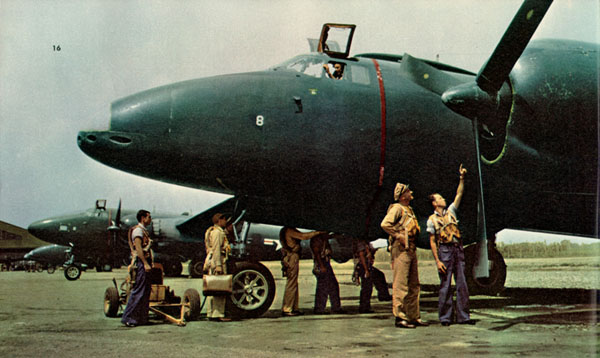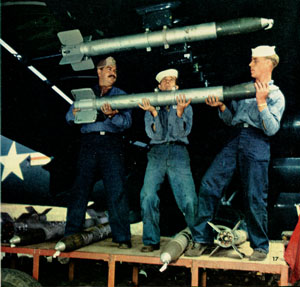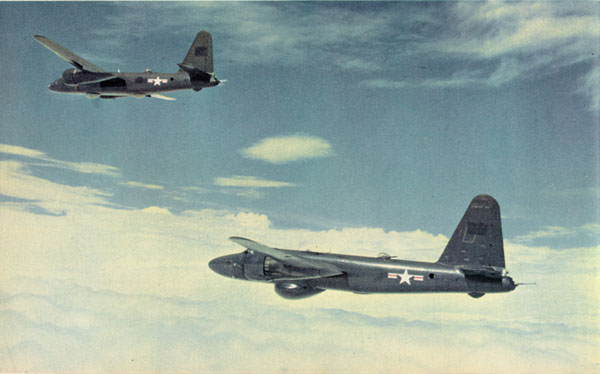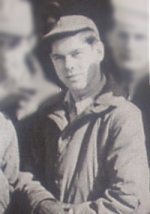BLUE SHARKS
Off the Red Coast
By John Conner
As Originally Published in Collier's October 28, 1950
Additional Commentary by Charles Pomeroy is appended

These Navy bombers, each packing the wallop of three destroyer broadsides,
interrupted routine patrols to strafe ground targets in fighter-plane style
Tokyo-At an air base in Japan, a Navy briefing officer was laying down the law to a group of pilots. "There will be no more firing at ground targets," he said grimly. "If there's to be any more shooting from now on it will be with cameras only. Or does anyone here want a court-martial?"
Thus ended a strange and wonderful chapter of the Korean war-a chapter which saw big, sleek, long-range patrol bombers, intended mainly for antisubmarine work, going out every day to wage war almost in the style of fighter planes: swapping angry bullets with beached Communist patrol boats, blasting railroad trains, bombing bridges from low altitudes. For the pilots of this Navy squadron, that kind of action was a lot better than spending long hours aloft looking for submarines that weren't there.
The squadron was one of the Navy's Blue Shark outfits-flying the shark-nosed, blue-hued P2V Neptune Patrol Bomber, successor to the clumsy, night-camouflaged Catalina, which was called The Black Cat in World War II.
Born to the fleet between the wars, the Neptune built up its reputation overnight in 1946 with the famed Truculent Turtle's spectacular nonstop flight from Australia to Columbus, Ohio-a performance that helped the Navy prove it had the longest-range two-engined bomber in the world. Although it is primarily a sub hunter and killer, the P2V has undertaken a wide variety of chores in Korea, watching the movement of Communist shipping, doing the spotting for warship gunnery, shepherding convoys into port and guarding the landing beaches during amphibious operations-acting, in short, as the eyes of the United Nations forces in the battle area. For this task, the Blue Shark is equipped with the latest radar equipment for peering through darkness and clouds.
But in addition to its electronic eyes, the P2V packs a powerful punch: rockets, bombs or torpedoes, and both 20-millimeter and .50-caliber guns. A full salvo of its rockets is equal to nearly three times the hitting power of a destroyer broadside. The Blue Shark crews, yanked out of a scheduled six-month training stint to patrol the Korean battle area, were initially ordered to attack any worthwhile target they saw in enemy territory, in a move to step up their proficiency with that imposing array of weapons. They cheerfully obeyed.
 VP-6 ordnance crew loading rockets
VP-6 ordnance crew loading rockets
Lieutenant Commander R. L. (Stretch) Ettinger, of Medford, Oregon, a six-foot five-inch giant who builds hot rods as a peacetime pastime, led the way. Ettinger hadn't fired in anger since his patrolling days of World War II and no one had yet felt the fiery bite of an attacking Shark, when one hot July day he saw a freight train steaming south out of Chongjin. He alerted Lieutenant Bill Pressler, of West Palm Beach, Florida, flying another Shark behind him, and then whipped down after the freight. Four rockets caught the string of cars dead middle and lifted two of them clear of the track in a slow, high roll. Then Ettinger called to his wingman: "Hot Rock, I want that engine. Get it for me."
Hot Rock came in steeply, spitting fire and lead. The engine boiler erupted as he swept overhead. For good measure, Pressler dropped a bomb on an undamaged railroad line on his way home, leaving a twisted loop of tracks to mark his passing.
As the air offensive against North Korea gained momentum, the Sharks, restricted largely to coastal patrols, tackled everything floating that had an enemy gun on it.
Lieutenant Commander E. B. Rogers, of Sumner, Mississippi, squadron executive officer, got into a cove one day to check on an island that looked suspiciously like a camouflaged boat. As he approached it in a shallow dive tracers came up to meet him.
"It looked as if someone was firing at me from a rock and from behind a tree," he said. "I made my run with rockets and 20-millimeters and came back for another. This time two of the 'rocks' let me have it and when I fired back eight more opened up. No matter where I turned I seemed about to get shot down.
"I got two of the boats at the waterline with rockets and then got out of there-with my skin whole and six holes in the plane."
The next day that same plane was shot up so badly that it had to ditch in the sea near Japan- thus ending the shooting exploits of the hard-flying Blue Sharks.
Ensign Bill Goodman of Fountain, Minnesota, and Lieutenant Commander Wylie Hunt, of San Diego-a World War II veteran who was shot down during the Battle of Midway and captured by the Japanese-were flying partners that day. Hunt, in the lead and out of Goodman's sight, made a rocket attack on a camouflaged gunboat off Chinnampo and maintained his course south toward Inchon. Goodman came on behind a few minutes later and, without knowing it had already been attacked, made a pass at the same vessel.
This time the North Koreans were ready. They met him with fire coming down and going away. The top turret gunner, Chief Machinist's Mate Houston Rhodes, of San Diego, saw the tracers coming up as Goodman climbed.
"Pilot from top turret-sir, we've got fire in the starboard engine."
 two vp-6 p2v's korean war
two vp-6 p2v's korean war
Goodman gunned his plane up to 1,000 feet, feathered the right engine and hurried out to sea to get away from the coast and capture. A P2V can fly on a single engine if it's light enough, and as this one headed home, its crew pitched everything loose out through the deck hatch.
The other engine began to smoke. Rhodes, an old hand who had escaped from the sinking carrier Lexington in World War II, called the pilot again. "Mr. Goodman, we'd better think about ditching. That burning wing is going to buckle."
But only when he heard that his radioman had contacted the base did the plane commander finally order: "Stand by to ditch."
The plane stayed afloat ten minutes. The crew timed her from their rubber rafts and then saw her slide under in a sigh of steam. In ten minutes more Hunt was circling overhead, signaling: "The British are coming."
Six hours later, just at dusk, a British cruiser and destroyer picked up the plane crew.
Back at the air base the next day the bad news arrived. Admiral Joy, chief of the Navy's Far East Command, had celebrated the first loss of a Blue Shark with an angry order. It was passed on at the preflight briefing. "No more shooting." With their expensive radar and other equipment, the P2Vs were just too valuable to lose that way.
The patrol missions aren't as exciting as they used to be for the Blue Shark squadron. In fact, they're pretty dull (in World War II, American pilots flew an average of 1,800 hours of patrol for every enemy sub sighted; in this war the hours of fruitless searching are even longer).
Nevertheless, in their painstaking patrols, the Neptunes may be doing noble duty by heading off submarine trouble before it starts. The squadron's leader. Commander Arthur F. Farwell, Jr. of Pensacola, Florida, knows how effective air patrols can be.
After the Japanese attacked Pearl Harbor, Farwell commanded a squadron whose slow flying boats were assigned the dusk-to-dawn antisubmarine watch from Cape May to Cape Hatteras on the east coast of the United States. Radar was crude in those days and Farwell's planes were not permitted to use flares because they would illuminate American shipping as well as German conning towers. So the Catalinas hunted and dived in the dark and the rate of reportable sinkings was low. Yet from May to June in 1942, the number of submarine sightings was cut down from 105 to three in the area.
"We were doing a lot of good but we didn't realize it until the statistics came in," said Farwell. "Then we knew our ventures had not been in vain. I think the same may be true today.
The End
---------------------------------------------------------
Additional Commentary by

Charles Pomeroy
In August of 1950, when the incident described in the Colliers article took place, I was an AL3 flying 2nd Radio with Crew 7. Lt. Cdr. Wiley M. Hunt was our PPC and also the squadron Operations officer. There were 12 planes in VP-6, including four P2V-3Ws, which carried the more powerful APS-20 radar, in addition to the eight P2V-3s described in the article. It was as a result of this article that the squadron became know as the "Blue Sharks." (Another correspondent "call me 'Buck'"--whose last name I've forgotten, flew an earlier mission with us in a P2V-3 in which we attacked a bridge with rockets, knocking out chunks of concrete but not the bridge itself. I believe he was with the Star Bulletin, although it may have been the Honolulu Advertiser.) Other members of Crew 7 during our first tour were Lt. Bo Doster (co-pilot), Lt.jg. Fred "Snide" Etherton (navigator, later replaced by Sam Rosenfeld). P. R. Foster (AD1/Plane Captain), C.V. Miller (AO1/Ordnance), and Jack Remington (ALC/1st Radio). I don't recall the name of our 2nd Mech. (Rosenfeld and Foster were later MIA when the Soviets shot down a VP-6 plane near Vladivostok on Nov. 6, 1951)
We had arrived at Johnson Air Force Base on July 7, 1950, and a month later moved to Tachikawa, a much larger base with ammo depots near at hand. For missions along the west coast of Korea, we first flew down to Iwakuni, which was then operated by the Australians, and used that as our forward base. The two P2V-3s described in the Colliers article were flown by Crews 7 and 5 on an interdict mission along the west coast of Korea in mid-August, around the 13th or 14th, as I recall, flying out of Iwakuni. These were the desperate days of the Pusan perimeter, and VP-6 had been very much involved in the effort to stop any south-bound movement from the north.
Both planes were armed with sixteen 5-inch rockets and several 500-lb. bombs and six 20 mm cannon in the nose, plus two 20 mm cannon in the tail turret and the two 50 cal. machine guns in the upper deck turret. Auxiliary fuel tanks were also carried on one side of the bomb bays. Crew 7 was in the lead plane with Hunt and Etherton at the controls; Doster had swapped positions with Etherton to give him some flight time in the right-hand seat. As the radio operator just aft of the cockpit, I had a view of the action by leaning back and looking over the shoulder of the plane captain, who was seated in the doorway of the cockpit.
Our second aircraft, BE-5 broke off to hit a target, a weir or small dam holding back rice-paddy water, with the intent of washing out the north-south road on which it faced. In the meantime, we proceeded down the coast at low altitude and, south of Chinnampo, came across a North Korean PC boat in a small inlet. Following the usual procedure, Hunt climbed to around 1,800 feet and pushed over into a rocket run. We soon started taking fire and I remember clearly hearing the co-pilot shouting at Hunt to "hit the 20s," meaning the six 20 mm cannon in the nose which were designed specifically for flak suppression.
We also started taking fire from the shoreline, where it seemed several other camouflaged PC boats were positioned. After breaking off from our attack, Hunt tried to contact BE-5 on VHF, but the low altitudes at which were operating in that mountainous terrain made contact impossible. Hunt then called for a try on CW, but just as I reached for the key an SOS came in from BE-5. They had flown into exactly the same situation and started a similar rocket attack on a target that was alert and ready. BE-5 was hit in the starboard engine, which caught fire, but they managed to ditch some 12 miles off the coast.
We returned immediately to their position, of course, and spotted Crew 5 in two rafts in the water, which we marked. We also spotted several North Korean PC boats headed out toward the rafts intent on capturing the downed crew. Hunt held them at bay, flicking a rocket in their direction to discourage them whenever they came too close. (Hunt, by the way, was a POW in WWII, captured by the Japanese after his PBY was downed, and wanted no one to suffer a similar fate.) Fortunately, we were able to contact the nearest ship, the H.M.S Kenya, a British light cruiser, which came on at full speed.
Calculations showed that by husbanding our fuel we could hold off the PC boats long enough for the Kenya to arrive. Hunt leaned back the engines, jettisoned our bomb-bay ordnance, and ordered all unnecessary gear thrown out the belly hatch, including ammo from the upper-deck and tail turrets. We continued to circle the rafts until the Kenya came into view (what a beautiful sight!) and we knew she would reach our guys before the PC boats. Immediately we headed for Iwakuni and only just made it. We made a straight-in landing, with the engines "sucking fumes," as P. R. Foster said. In fact, the port engine stopped turning over as we taxied off the runway.
A month later, the crew of BE-5 returned to Tachikawa, except for Dick Colley (AL3), who had received burns in his position at radar just aft of the wing on the starboard side. Dick was sent to the hospital at Yokosuka, where I later visited him (we both made AL2 in the following month). The crew had spent two days aboard the Kenya and then been transferred to a Canadian destroyer, the Cockade. In addition to Dick Colley and "Dusty" Rhodes, who was named in the article above, other crew members were Otis Rhea in the radio position (Otis was also an excellent saxophonist), John Scott (AOC) and Chief Hertzog as the ordnancemen, Carl Whitsle (AM1) as 2nd Mech, and Robert Greenkorn (Ens) as navigator with a midshipman trainee by the name of David Styles, the first to see combat since the days of sailing ships. As co-pilot to Bill Goodman was Richard "Sully" Sullivan, who became my PPC during our second tour.
We believed at the time that we had flown into a flak trap, which the unfortunate shoot-down seemed to bear out. The name given VP-6 by the Colliers article stuck and all who served in the squadron since have become proud to be known as Blue Sharks. As Fred Etherton noted at the October, 2002, Alpine get-together of guys from the '50-'53 era, VP-6 had racked up a number of firsts. We were the first Navy squadron sent into the Korean conflict, we flew the first P2Vs into combat, and we were first in decorations (91 DFCs plus several hundred Air Medals). We were also the only squadron to participate in all five major battles of the Korean War. The squadron completed two tours during that period: the first from early July of '50 to mid-February of '51 and the second from August of '51 to February of '52.
Charles Pomeroy
Former AL1 who served in VP-27, VP-6, VP-9, U.S. Naval Attache (Rome), and VP-11 from 1948 through 1956.